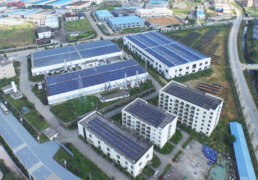First appeared in

Asian Development Bank
100 Climate Actions from Cities in Asia and the Pacific
After three years of implementing several projects within solar, wind, and biomass energy, Kaihua County in Quzhou is striving to become a low-carbon leader.
After three years of implementing several projects within solar, wind, and biomass energy, Kaihua County in Quzhou is striving to become a low-carbon leader.
Located in the westernmost portion of Zhejiang province, Quzhou was recently occupied with new energy development projects. From 2016 to 2018, several projects were raising the local share of renewable energy using solar photovoltaic and thermal energy, wind energy and biomass.
30K
TONS OF COAL SAVED
TONS OF COAL SAVED
In terms of solar energy, photovoltaic power has been a strong focus, with a total of 136 megawatts (MW) of additional capacity installed to date, with rooftop, agricultural, and dispersed installations occurring in the region. Solar thermal has also been targeted, with a total estimated area of 16,000 square meters of panel coverage — that’s roughly two times as big as a Manhattan city block.
Wind and biomass energy are also being harnessed by Quzhou at the moment, with the 60 MW of newly installed wind power and biomass utilisation saving an estimated 30 thousand tons of coal in total.

Photovoltaic solar power has been a big focus for Quzhou, where they have installed 136 MW to date (photo by Rui Jia).
The Challenge
Energy consumption in Quzhou
relies heavily on coal.
Co-Benefits
Health Displacing fossil fuel energy generation with renewable energy will contribute to an improved local air quality and corresponding health of citizens.
Environment In addition to the renewable energy developments, the project is also establishing a reforestation area of 62,400 acres in size.

